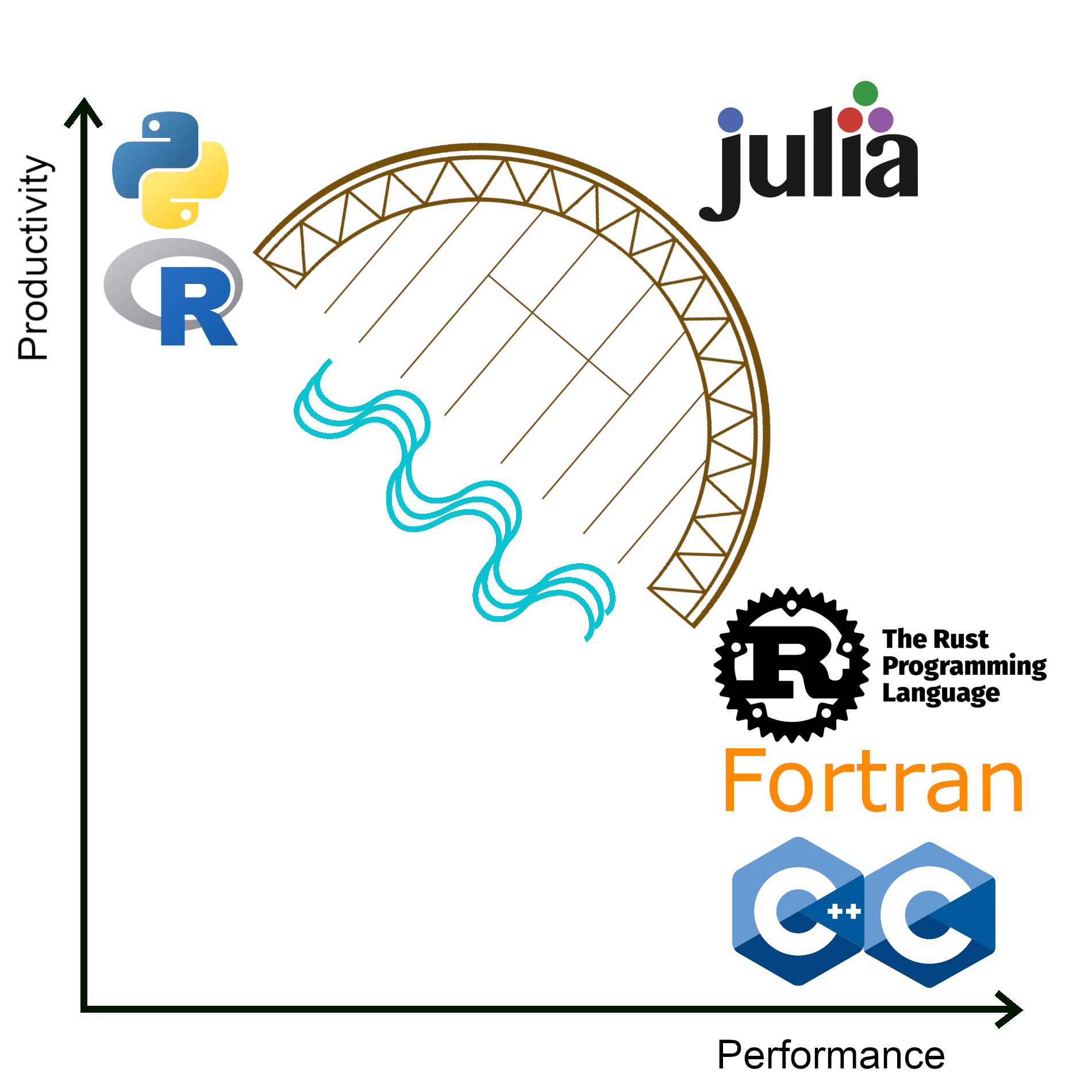Introduction Julia
- Welcome page and syllabus
Also link at House symbol 🏠 at top of page
Learning outcomes
Learn how to load Julia modules and access site-installed Julia packages
Grasp the concept of Julia environments
Familiarize with Julia packages installation with Pkg
Acquire the knowledge of writing batch scripts for running Julia
Discover and explore the different Julia parallelization tools
Learn how Julia supports GPU computing
Gain knowledge on how to run ML jobs in Julia
Your expectations?
Find best practices for using Julia at UPPMAX and HPC2N
Get the hang of packages functioning
Use the HPC performance with Julia
Not covered
Improve Julia coding skills
Other clusters
Julia Exercise files
On HPC2N, you can copy the Julia exercises in a tarball from
/proj/nobackup/r-py-jl-m/exercises.tar.gzOn UPPMAX you can copy the exercises in a tarball from
/proj/r-py-jl-m-rackham/exercises.tar.gzOn LUNARC you can copy the exercises in a tarball from
~bbrydsoe/exercises.tar.gz
Exercises
You can download the exercises from the course GitHub repo, under the “exercises” -> “julia” directory: https://github.com/UPPMAX/R-python-julia-matlab-HPC/tree/main/exercises/julia
Copy the file and un-tar it in you personal project folder you created a while ago (https://uppmax.github.io/R-python-julia-matlab-HPC/index.html#prepare-your-environment-now). Finally enter the directory and list the content with the
treecommand.
cd /proj/r-py-jl-m-rackham/<your-name> # on Rackham
cd /proj/nobackup/r-py-jl-m/<your-name> # on Kebnekaise
cp ../exercises.tar.gz .
tar zxvf exercises.tar.gz
tree exercises/julia
Preliminary schedule
Time |
Topic |
Teacher |
|---|---|---|
9:00 |
Log in |
BC, PO |
9.45 |
Coffee break |
|
10:00 |
Syllabus |
BC |
10.15 |
Introduction, Julia in general |
PO |
10.25 |
Loading modules and running Julia codes |
BC |
10.55 |
Break |
|
11.10 |
Packages and isolated environments |
PO |
12.00 |
LUNCH |
|
13.00 |
SLURM Batch scripts for Julia jobs |
PO |
13.50 |
break |
|
14.05 |
Parallel and multithreaded functions |
PO |
14.50 |
break |
|
15.00 |
Simultaneous session — UPPMAX: Jupyter and interactive work |
BC |
. |
Simultaneous session — HPC2N: Jupyter |
PO |
15.25 |
Summary |
BC |
15.30 |
Evaluation |
|
15.40 |
Q&A on-demand |
|
16.00 |
END |
Instructor note
Intro 5 min
Lecture and 10 min
What is Julia?
Julia is a relatively new Programming language (pre-released 1.0 announced in 2018), compared to well-known and standard languages such as Fortran, C, C++, R, and Python (some of them dated back to the 70’s). A common pattern in those well-established languages (traditional paradigm) is that they look after either:
productivity (fast deployment, fast prototyping) or,
performance (fast numerical computations).
This pattern created the so called two-language problem where programmers had to choose between productivity (R, Python) or performance (Fortran, C/C++) and when both were needed programmers had to learn the language that offered the desired capability and use some interface between different languages. Performant languages traditionally need to be compiled while languages focusing on productivity are interpreted.
Among the different features of Julia, is its capability of integrating both aspects productivity and performance into a single language. In this way, Julia programmers can in principle write software without changing their focus to learn a new language.

Two-language problem where Julia is shown as a bridge between the languages in the traditional paradigms, productivity vs. performance.
Features of Julia
According to the Julia documentation some of the features of this language are:
Good Base library with efficiently implemented operations written in Julia itself
“Good performance, approaching that of statically-compiled languages like C”
Modular and self-contained approach for libraries and development
“A rich language of types for constructing and describing objects”
A fast growing community of users and developers
Shortcomings of Julia
As this is a new language, the libraries ecosystem is not as rich as in Python or R, for instance
Currently, using Julia for simple tasks (for instance, opening a file and writing text, plotting) is not as efficient as using Linux tools (AWK, GREP) or compiled languages (Fortran, C/C++, Rust)
Previous situation is more noticeable upon running simple tasks in parallel mode (MPI, Threads)
An initial code version can be fast (compared to base Python) with a code that is clear to novices and without spending a long time writing. However, if one needs to get a more optimized code, it would most likely increase its complexity (readability) and one would need to spend more time (learning/programming) as in the case of C/C++/Fortran.
More on Julia
- Documentation at the HPC centres UPPMAX and HPC2N
LUNARC: The user demand on Julia has been low, so there is currently no site-specific documentation.
Official Julia documentation is found here:
Slack channel for Julia and instructions for joining it are found here: https://julialang.org/slack/
Material for improving your programming skills
First level
The Carpentries teaches basic lab skills for research computing.
Programming with Julia (alpha)
Second level
CodeRefinery develops and maintains training material on software best practices for researchers that already write code. Their material addresses all academic disciplines and tries to be as programming language-independent as possible.
Not yet anything Julia specific
ENCCS (EuroCC National Competence Centre Sweden) is a national centre that supports industry, public administration and academia accessing and using European supercomputers. They give higher-level training of programming and specific software.
Other NAISS centres
Keypoints
Julia is a relatively new language with several attractive features.
Julia purpose is to avoid changing between high performance and high productivity languages in the different phases of code development.